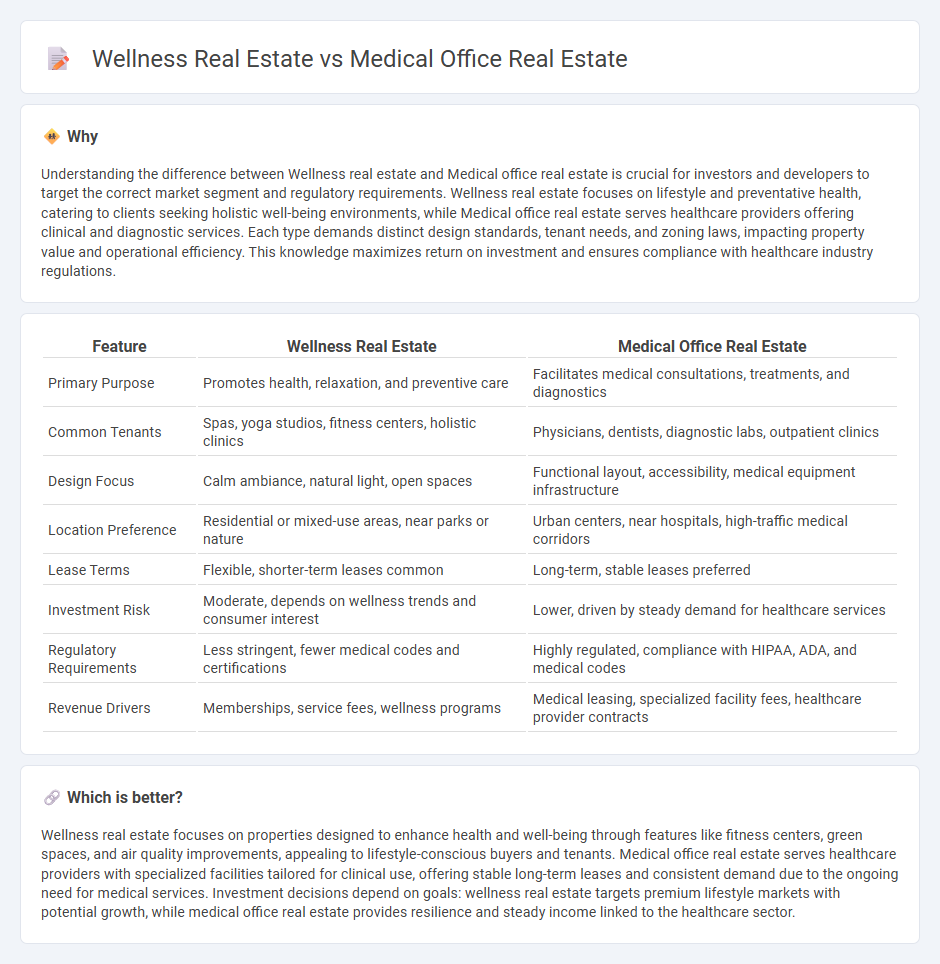
Wellness real estate focuses on properties designed to enhance health and well-being, including residential communities with fitness centers, spas, and green spaces. Medical office real estate consists of buildings specifically suited for healthcare providers, such as clinics, diagnostic centers, and physician offices, emphasizing accessibility and specialized infrastructure. Explore the key differences and benefits of wellness versus medical office real estate to optimize your property investment strategy.
Why it is important
Understanding the difference between Wellness real estate and Medical office real estate is crucial for investors and developers to target the correct market segment and regulatory requirements. Wellness real estate focuses on lifestyle and preventative health, catering to clients seeking holistic well-being environments, while Medical office real estate serves healthcare providers offering clinical and diagnostic services. Each type demands distinct design standards, tenant needs, and zoning laws, impacting property value and operational efficiency. This knowledge maximizes return on investment and ensures compliance with healthcare industry regulations.
Comparison Table
| Feature | Wellness Real Estate | Medical Office Real Estate |
|---|---|---|
| Primary Purpose | Promotes health, relaxation, and preventive care | Facilitates medical consultations, treatments, and diagnostics |
| Common Tenants | Spas, yoga studios, fitness centers, holistic clinics | Physicians, dentists, diagnostic labs, outpatient clinics |
| Design Focus | Calm ambiance, natural light, open spaces | Functional layout, accessibility, medical equipment infrastructure |
| Location Preference | Residential or mixed-use areas, near parks or nature | Urban centers, near hospitals, high-traffic medical corridors |
| Lease Terms | Flexible, shorter-term leases common | Long-term, stable leases preferred |
| Investment Risk | Moderate, depends on wellness trends and consumer interest | Lower, driven by steady demand for healthcare services |
| Regulatory Requirements | Less stringent, fewer medical codes and certifications | Highly regulated, compliance with HIPAA, ADA, and medical codes |
| Revenue Drivers | Memberships, service fees, wellness programs | Medical leasing, specialized facility fees, healthcare provider contracts |
Which is better?
Wellness real estate focuses on properties designed to enhance health and well-being through features like fitness centers, green spaces, and air quality improvements, appealing to lifestyle-conscious buyers and tenants. Medical office real estate serves healthcare providers with specialized facilities tailored for clinical use, offering stable long-term leases and consistent demand due to the ongoing need for medical services. Investment decisions depend on goals: wellness real estate targets premium lifestyle markets with potential growth, while medical office real estate provides resilience and steady income linked to the healthcare sector.
Connection
Wellness real estate and medical office real estate are interconnected through their focus on health-centered environments that promote physical and mental well-being. Properties designed for wellness real estate often incorporate medical office spaces to provide accessible healthcare services, enhancing resident health and lifestyle quality. This integration supports a growing market demand for holistic living spaces that combine residential amenities with professional medical care.
Key Terms
**Medical Office Real Estate:**
Medical office real estate primarily serves healthcare providers by offering specialized facilities designed for clinical use, such as examination rooms, imaging centers, and outpatient services, making it essential for efficient patient care delivery. These properties often feature compliance with healthcare regulations, proximity to hospitals, and accessibility for patients, distinguishing them from wellness real estate, which focuses more on preventive and lifestyle-oriented services. Explore the unique benefits and investment potential of medical office real estate to understand its critical role in the healthcare infrastructure.
Clinical Compliance
Medical office real estate requires stringent adherence to clinical compliance standards, including patient privacy, medical waste disposal, and accessibility regulations. Wellness real estate focuses more on creating therapeutic environments while maintaining health and safety guidelines, but typically involves less rigorous clinical compliance. Explore the key differences in regulatory requirements and facility design to understand how each sector impacts operational effectiveness.
Triple Net Lease (NNN)
Medical office real estate frequently utilizes Triple Net Lease (NNN) agreements, transferring property taxes, insurance, and maintenance costs to tenants, ensuring predictable income for landlords. Wellness real estate, including fitness centers and spa facilities, may adopt NNN leases but often involves shorter lease terms and higher turnover, impacting income stability. Explore detailed insights on how NNN lease structures influence investment strategies in both medical office and wellness real estate sectors.
Source and External Links
Medical Office Properties for Sale - Marcus & Millichap - Provides specialized real estate advisory services for medical office properties nationwide, handling investment sales and offering expertise in healthcare real estate to optimize investment value.
A Guide to Investing the Right Way in Medical Office Buildings - Explains the unique characteristics of medical office buildings (MOBs), highlights their growing demand due to demographic trends, and notes the rising prevalence of suburban and rural locations with modern, LEED-certified MOB construction.
Investing in Medical Office Buildings - Physician Side Gigs - Discusses key investment considerations for MOBs including prime location factors like population density, proximity to hospital systems, parking availability, and visibility, which all impact long-term investment success.
 dowidth.com
dowidth.com